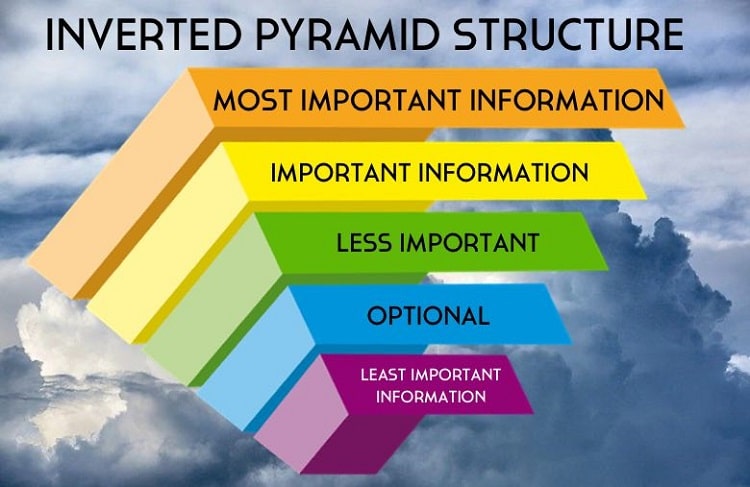My content is reader-supported by awesome people like you. Which means I could earn a commission. Learn more here!
Many people think that knowledge of SEO tactics is what makes a good content writer.
However, that is just half the story.
Even if someone is an SEO whiz, that doesn’t necessarily mean they can write good content.
Writing good content is about connecting with your audience and tailoring your writing style to your content needs.
If you want to start writing the content yourself but are unsure how to start, you have come to the right place.
This guide will teach you how to write well.
We will cover the most important aspects of writing good content:
connecting with readers, using the inverted pyramid model, and making text scannable.
While it is impossible to become an amazing writer overnight, if you use these tips and put them to practice, you will be there in no time.
Let’s get into it.
Know Your Audience

The first step to writing good content is knowing your audience.
You should tailor your content to your customers, fans, and followers.
Otherwise, it won’t be interesting for them to read.
When you connect with your audience, your followers will be more likely to turn into longtime customers of your business.
They will feel that connection, and they will appreciate it.
There are a few easy ways you can do this.
Read Comments and Feedback
One of the easiest ways to learn about your audience is to read comments on your posts.
Find out what they enjoyed and what they didn’t.
Often, followers will share personal stories and experiences in the comments sections to relate to you as the writer or other followers.
You can typically see a pattern in the comment section regarding the kinds of people that follow you.
This information is very valuable.
Furthermore, if a customer/follower gives you feedback, do not ignore it.
Even though some feedback may sound negative, it may be worth thinking about what they said to see if you can improve anything (your tone on certain subjects, for example).
Positive feedback is also helpful. Learn what your followers enjoyed about the post and try to repeat it in the future.
Collect and Review Data
Another thing you can do is collect and review data to learn more about your audience.
To collect data, consider running a survey.
The purpose of a survey is to find out what feedback your customers have regarding your content.
For example, ask them what content they want to see (buying guides, response posts, etc.) and what content they don’t like.
After you receive your survey results, review the data and create a plan to implement the feedback.
While you don’t have to listen to everything each follower says, it will give you a good idea of your audience’s preference.
Inverted Pyramid Model

When someone asks a journalist for advice on how to write well, one of the top answers they will give is to follow the inverted pyramid model.
The inverted pyramid model is a writing technique that many journalists use to write a coherent article.
The model emphasizes what kind of information that the writer should prioritize.
According to the model, you should put the most newsworthy info at the top of the story.
This info can include the who, what, where, when, and why.
Also, try to keep your introduction short.
The middle of the article is where all of the important details of the story will be.
As you write, you should be adding more and more supporting details and data to whatever you are writing about.
Try to get more specific as you go.
Finally, the conclusion of the article is where you should put other general information and background info.
While using the inverted pyramid model is unnecessary for every piece of text, it is a great guide for beginner content writers.
Here are a few benefits of using the inverted pyramid method:
- The method hooks readers quickly. Readers find it annoying when they have to read three paragraphs of fluff before getting to the good stuff. When you put the most newsworthy information at the beginning of the article, they will be hooked and interested in reading the rest of the story.
- The inverted pyramid is good for SEO. Search engines tend to look for short paragraphs that answer the question in clear language. When you use this method, you will have a solid answer paragraph at the top of your article, making it more likely that search engines will pick your content up.
- This method of writing gets straight to the point. Your readers will love that they can get the gist of the article in the first few sentences. Even if they are short on time, they can still benefit from reading your content.
Keep It Short and Precise

The biggest mistake that new content writers make is thinking that more words are better.
However, this is not necessarily the case.
When writing an article, no matter how large the targeted word count is, try to avoid adding fluff.
Fluff is generally any information that is repeated or non-relevant to the blog.
Instead, try to write short and precise sentences.
Only write information that is related and vital to the topic.
Furthermore, avoid dragging a single point on forever.
If you find yourself struggling to explain a concept, you probably don’t understand it fully.
Instead, take the time to do some more research and write the concept again from scratch.
It is also worth mentioning that a 3000-word article can still be short and precise.
If the article is not full of worthless fluff but manages to give original and helpful information in every paragraph, then I would consider the blog short and precise.
Don’t Repeat Yourself
If you are wondering how to write well, this will be crucial to understand and implement in your writing.
Something that will get on the reader’s nerves is if you constantly repeat yourself.
While repeating information is a useful marketing tactic in certain situations, it does not make for good content writing most of the time.
If you find yourself repeating concepts over and over again, you may need to step back and objectively analyze your article for a second.
There are a few reasons this could be happening.
The first reason is that you are not very knowledgeable about what you are talking about.
For instance, maybe you only understand one aspect of the subject matter.
People tend to write what they know, so you will most likely keep repeating what you understand.
If this is the case, take some time and do more research.
Then, when you finish the first draft, make sure to review it and delete any sections that repeat information.
The second and most common reason you repeat yourself is that you simply don’t have enough information to fill the word count.
Perhaps you want to write a 2500 word blog post on a topic.
If there is not much information out there on the subject, you simply can’t write seven pages on it, no matter how good of a writer you are.
If you find yourself in this situation, cut your word count down.
It is much more valuable to have a high-quality article than a blog post filled with repeated information.
Make Text Scannable

If you are wondering how to write well, especially when it comes to your website content, you should follow this number one rule.
Make your text scannable!
“Why should I do this?” you may ask.
The reason is that over 50% of people on the internet simply scan content.
Thus, most readers do not read every word of an article, especially when they are looking for a specific answer.
There are a few easy ways you can make your text scannable.
- Use headings and subheadings. Breaking your text apart with headings and subheadings is crucial. This will make it easier for readers to find the answer they want quickly. It will also make it look like your article is smaller and easier to read than it actually is. Think about it: 3000 words looks a lot different when it is in one long chunk compared to short paragraphs under multiple headings.
- Write concise headlines. Your readers should be able to understand what your article is about by only reading the headlines. They should be able to scan the headlines, read a few sentences, and get the gist.
- Write an answer paragraph at the top. An answer paragraph is basically a few sentences answering the question of your article/summing up your article. You can put this in your intro. Not every article needs this, but it can be helpful.
- Keep your paragraphs under five sentences long. It is hard to read paragraphs over five sentences long, especially on mobile devices. If you want your blog to be easy to read, try to aim for three sentences per paragraph.
- Incorporate lists when you can. Lists will jump out at readers and will be the main thing that draws their eye. They are also very easy to read. Incorporate lists when you can, either in the form of headings, numbers, or bullet points.
Multimedia Matters
Even if you are an amazing content writer, many potential readers will click off your blog post if they don’t see pictures.
There are a few reasons for this.
At first glance, an article may look very information-condensed.
It is overwhelming to some people to see 2000 words of information on a screen.
However, pictures break the text up and make it easier (and more enjoyable) to read.
Furthermore, you can use pictures and videos to explain a point or concept further.
Many readers will be visual learners and will greatly benefit from instructional pictures and graphics.
Here are a few things to keep in mind when adding media to your post.
- Use high-resolution graphics
- Make sure you are using royalty-free images or creative commons images
- Only use clear images
- Use screenshots to illustrate your point
- Use authoritative videos
- Add an alt text to your image for SEO purposes
DON’T PLAGIARIZE!

Last but not least is plagiarism.
If you want to know how to write well, understanding plagiarism is important and should be taken seriously, even when it comes to a blog post.
We all know how to avoid plagiarism: just don’t do it.
But sometimes, it is not that simple.
Even the best of writers can accidentally plagiarize information; we are all human!
Here are some ways to avoid plagiarism in your content.
- Use multiple websites for research. If you are not familiar with your topic, you will have to do some research. When you find a good resource, it is tempting to only use that resource for information. However, this could lead to unintentional plagiarism. To avoid this, use at least three different authoritative sources for your subject.
- Always link to the original sources. Make sure to always link to the original source you got the information from. You can do this by providing an in-text link or listing your sources as a bullet point list at the end of your article.
- Use a plagiarism checker. Finally, use a plagiarism checker before uploading your content to the web. Websites such as Grammarly and CopyScape are good resources.
Conclusion
We hope that this guide has helped you learn how to write well.
Writing good content is not rocket science; all it takes is a little practice.
There are a few things to remember when writing content.
First of all, know your audience and tailor your content to the needs of your readers.
Learn more about your followers by reading comments and running surveys.
Secondly, try to use the inverted pyramid model as a base template for your first few articles.
Write the most newsworthy information at the top and all of the important details in the body paragraphs.
Keep your writing short and precise, and try not to repeat yourself.
Most importantly, make your text scannable.
Use headings and subheadings, and keep your paragraphs under five sentences long.
Furthermore, add some pictures and videos to your post to drive the point home.
Finally, don’t plagiarize. Use multiple resources for research, always link to sources, and use a plagiarism checker.





Great article. It’s very easy to understand your article. All these tips are really helpful for write good content. Thanks for sharing.
Hey James,
Appreciate your thoughts on this.
Thanks,
Chris